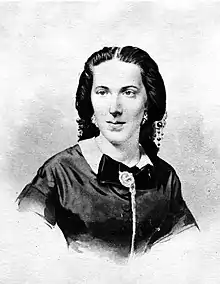Belle Boyd
Isabella Maria Boyd (May 9, 1844[1] – June 11, 1900[2]), best known as Belle Boyd (or as Cleopatra of the Secession or Siren of the Shenandoah), was a Confederate spy in the American Civil War. She operated from her father's hotel in Front Royal, Virginia, and provided valuable information to Confederate General Stonewall Jackson in 1862.
Belle Boyd | |
|---|---|
 | |
| Born | Isabella Maria Boyd May 9, 1844 Martinsburg, Virginia (now West Virginia), US |
| Died | June 11, 1900 (aged 56) |
| Other names | Belle Boyd, Cleopatra of the Secession, Siren of the Shenandoah, La Belle Rebelle, Rebel Joan of Arc |
| Occupation | Confederate Spy |
.jpg.webp)
Early life
Isabella Maria Boyd was born on May 9, 1844 in Martinsburg, Virginia (now part of West Virginia).[3] She was the eldest child of Benjamin Reed and Mary Rebecca (Glenn) Boyd.[4] She described her childhood as idyllic.[5] After some preliminary schooling in Martinsburg, she attended finishing school at the Mount Washington Female College in Baltimore, Maryland in 1856 at age 12.[6]
Southern spy
Boyd's espionage career began by chance. According to her highly fictionalized 1866 account, a band of Union army soldiers heard that she had Confederate flags in her room on July 4, 1861, and they came to investigate. They hung a Union flag outside her home. Then one of the men cursed at her mother, which enraged Boyd. She pulled out a pistol and shot the man, who died some hours later. A board of inquiry exonerated her of murder, but sentries were posted around the house and officers kept close track of her activities. She profited from this enforced familiarity, charming at least one of the officers whom she named in her memoir as Captain Daniel Keily,[7] She wrote in her memoir that she was indebted to Keily "for some very remarkable effusions, some withered flowers, and a great deal of important information."[8] She conveyed those secrets to Confederate officers via her slave Eliza Hopewell, who carried them in a hollowed-out watch case. Boyd was caught on her first attempt at spying and told that she could be sentenced to death, and she realized that she needed to find a better way to communicate.
General James Shields and his staff gathered in the parlor of the local hotel in mid-May 1862. Boyd hid in the closet in the room, eavesdropping through a knothole that she enlarged in the door. She learned that Shields had been ordered east from Front Royal, Virginia. That night, she rode through Union lines, using false papers to bluff her way past the sentries, and reported the news to Colonel Turner Ashby, who was scouting for the Confederates. She then returned to town. When the Confederates advanced on Front Royal on May 23, Boyd ran to greet Stonewall Jackson's men, avoiding enemy fire that put bullet holes in her skirt. She urged an officer to inform Jackson that "the Yankee force is very small [...] Tell him to charge right down and he will catch them all."[9] Jackson did and wrote a note of gratitude to her: "I thank you, for myself and for the army, for the immense service that you have rendered your country today."[10][11] For her contributions, she was awarded the Southern Cross of Honor. Jackson also gave her captain and honorary aide-de-camp positions.[12]
Boyd was arrested at least six times but somehow evaded incarceration.[13] By late July 1862, detective Allan Pinkerton had assigned three men to work on her case.[14] She was finally captured by Union officials on July 29, 1862, after her lover gave her up, and they brought her to the Old Capitol Prison in Washington, D.C. the next day.[15][16] An inquiry was held on August 7, 1862 concerning violations of orders that Boyd be kept in close custody.[17] She was held for a month before being released on August 29, 1862, when she was exchanged at Fort Monroe.[18] She was arrested again in June 1863, but was released after contracting typhoid fever.[19]
In March 1864, Boyd attempted to travel to England, but she was intercepted by a Union blockade and sent to Canada.[19] where she met Union naval officer Samuel Wylde Hardinge. The two later married in England.[19] and had a daughter named Grace.[20] Boyd became an actress in England after her husband's death to support her daughter. Following the death of her husband in 1866, she and her daughter returned to the United States.[20] Boyd assumed the stage name Nina Benjamin to perform in several cities, eventually ending up in New Orleans where she married John Swainston Hammond in March 1869, a former British Army officer who fought for the Union Army during the Civil War.[21] They had two sons and two daughters; their first son died as an infant. Boyd divorced Hammond in 1884 and married Nathaniel Rue High in 1885. She subsequently began touring the country giving dramatic lectures of her life as a Civil War spy.[21]
Post-War years and death

Boyd published a highly fictionalized narrative of her war experiences in the two-volume Bell Boyd in Camp and Prison.[22] She died of a heart attack in Kilbourn City, Wisconsin (Wisconsin Dells) on June 11, 1900 at age 56. She was buried in the Spring Grove Cemetery in Wisconsin Dells, with members of the Grand Army of the Republic as her pallbearers.[23] For years, her grave simply read:
- BELLE BOYD
- CONFEDERATE SPY
- BORN IN VIRGINIA
- DIED IN WISCONSIN
- ERECTED BY A COMRADE[24]
In popular culture
- The Smiling Rebel is Harnett Kane's 1955 novel about Boyd.[25]
- Boyd is a main character in Cherie Priest's 2010 steampunk novel Clementine and its 2013 sequel Fiddlehead.[26]
- Boyd appears as a character in book 3 of the James Reasoner Civil War Series.
- Boyd's bullet-riddled handbag was the featured artifact on an episode of the TV game show Legends of the Hidden Temple.
- Boyd appears as a master-spy in the Firaxis computer game Civilization 4 Beyond The Sword
References
- The date in the Boyd Family Bible is May 4, 1844 (Scarbrough, Ruth (1997). Belle Boyd: Siren of the South. Macon, Georgia: Mercer University Press. p. 2. ISBN 978-0-86554-555-7.), but Boyd insisted that it was 1844 and that the entry was in error. (Sigaud, Louis A. (1944). Belle Boyd, Confederate Spy. Richmond, Virginia: Dietz Press. p. 224. OCLC 425072.) See also Hay 1975, p. 215. Despite Boyd's assertion, many sources give the year of birth as 1844 and the date as May 10 (Barnhart, Clarence L.; et al., eds. (1954). "Boyd, Belle". The New Century Cyclopedia of Names. 1. New York: Appleton-Century-Crofts., "Belle Boyd: Chapter No. 2620". Belle Boyd Chapter of the Louisiana Division of the United Daughters of the Confederacy via RootsWeb of Ancestry.com.)
- Trust, Civil War (2014). "Maria "Belle" Boyd". Civilwar.org. Retrieved July 29, 2014.
- Fredriksen, John C. (2001). America's Military Adversaries: From Colonial Times to the Present. ABC-CLIO. p. 64. ISBN 9781576076033.
- PhD, Wilmer L. Jones (May 1, 2015). Behind Enemy Lines: Civil War Spies, Raiders, and Guerrillas. Rowman & Littlefield. p. 59. ISBN 9781630760878.
- Boyd, Belle; Hardinge, Sam Wilde (1865). Belle Boyd in Camp and Prison. Saunders, Otley, and Company. pp. 38.
- Scarborough, Ruth (1997). Belle Boyd: Siren of the South. Mercer University Press. p. 5. ISBN 9780865545557.
- Bakeless, p. 155
- Boyd, p. 102
- Connelly, Owen (January 10, 2009). On War and Leadership: The Words of Combat Commanders from Frederick the Great to Norman Schwarzkopf. Princeton University Press. p. 40. ISBN 9781400825165.
- Winkler, H. Donald (September 1, 2010). Stealing Secrets: How a Few Daring Women Deceived Generals, Impacted Battles, and Altered the Course of the Civil War. Sourcebooks. p. 217. ISBN 9781402242861.
- Boyd, Belle (1865). Belle Boyd in Camp and Prison. With an introduction by a Friend of the South. New York: Blelock & Company. p. 133. LCCN 29025240. OCLC 560396348.
- Smith, Vicki. "Civil War guide touts spy, life off battlefields". Associated Press. WTOP. Archived from the original on June 16, 2013. Retrieved April 21, 2011.
- Bell, Jerri; Crow, Tracy (2017). It's My Country Too: Women's Military Stories from the American Revolution to Afghanistan. U of Nebraska Press. p. 31. ISBN 9781612348315.
- Waller, Douglas (August 6, 2019). Lincoln's Spies: Their Secret War to Save a Nation. Simon and Schuster. p. 204. ISBN 9781501126840.
- Official Records, p. 310, Series 2, Vol. 4
- Hastedt, Glenn P. (2011). Spies, Wiretaps, and Secret Operations: An Encyclopedia of American Espionage. ABC-CLIO. p. 105. ISBN 9781851098071.
- Official Records, p. 349, Series 2, Vol. 4
- Official Records, p. 461, Series 2, Vol. 4
- Tsui, Bonnie (2006). She Went to the Field: Women Soldiers of the Civil War. Guilford: Two Dot. p. 95. ISBN 9780762743841.
- Scarborough 1997, p. 179.
- Scarborough 1997, p. 180.
- Tsui, Bonnie (2006). She Went to the Field: Women Soldiers of the Civil War. Guilford: Two Dot. p. 97. ISBN 9780762743841.
- The GPS coordinates for Spring Grove Cemetery are 43.62560, −89.75280 and for the grave of Belle Boyd are 43.625695, −89.754068
- Wisconsin Historical Society
- "Hartnett T. Kane (1910–1984)". librarything.com. Retrieved August 2, 2014.
- Siemann, Catherine (October 31, 2018). "Cherie Priest: At the intersection of History and Technology". In Murphy, Bernice (ed.). Twenty-First-Century Popular Fiction. Edinburgh University Press. pp. 227–37. ISBN 9781474414869.
Further reading
- Abbott, Karen (2014). Liar, Temptress, Soldier, Spy: Four Women Undercover in the Civil War. HarperCollins. ISBN 9780062092892. OCLC 878667621.
- Bakeless, John. Spies of the Confederacy. Mineola, N.Y.: Dover Publications, 1997.
- Boyd, Belle. Belle Boyd in Camp and Prison. New York: Blelock, 1867.
- Harnett Thomas Kane, The Smiling Rebel (Garden City, New York: Doubleday, 1955).
- Hay, Thomas Robson (1975). "Boyd, Belle". In James, Edward T.; et al. (eds.). Notable American Women, 1607–1950: A Biographical Dictionary. 1. Cambridge. Massachusetts: Belnlknap Press of Harvard University Press.
- Sigaud, Louis A. (1944). Belle Boyd, Confederate Spy. Richmond, Virginia: Dietz Press. OCLC 425072.
- Sizer, Lyde Cullen. "Belle Boyd". American National Biography. Oxford University Press.
External links
| Wikimedia Commons has media related to Maria Isabella Boyd. |
- Belle Boyd in Camp and Prison. In Two Volumes. Vol. I. London: Saunders, Otley, and Co., 1865.
- Belle Boyd in Camp and Prison. In Two Volumes. Vol. II. London: Saunders, Otley, and Co., 1865.
- Belle Boyd: Siren of the South By Ruth Scarborough
- Belle Boyd in Encyclopedia Virginia
- Belle Boyd, Wisconsin Historical Society
- Official Records Retrieved June 14, 2009
- Michals, Debra. "Belle Boyd". National Women's History Museum. 2015.
